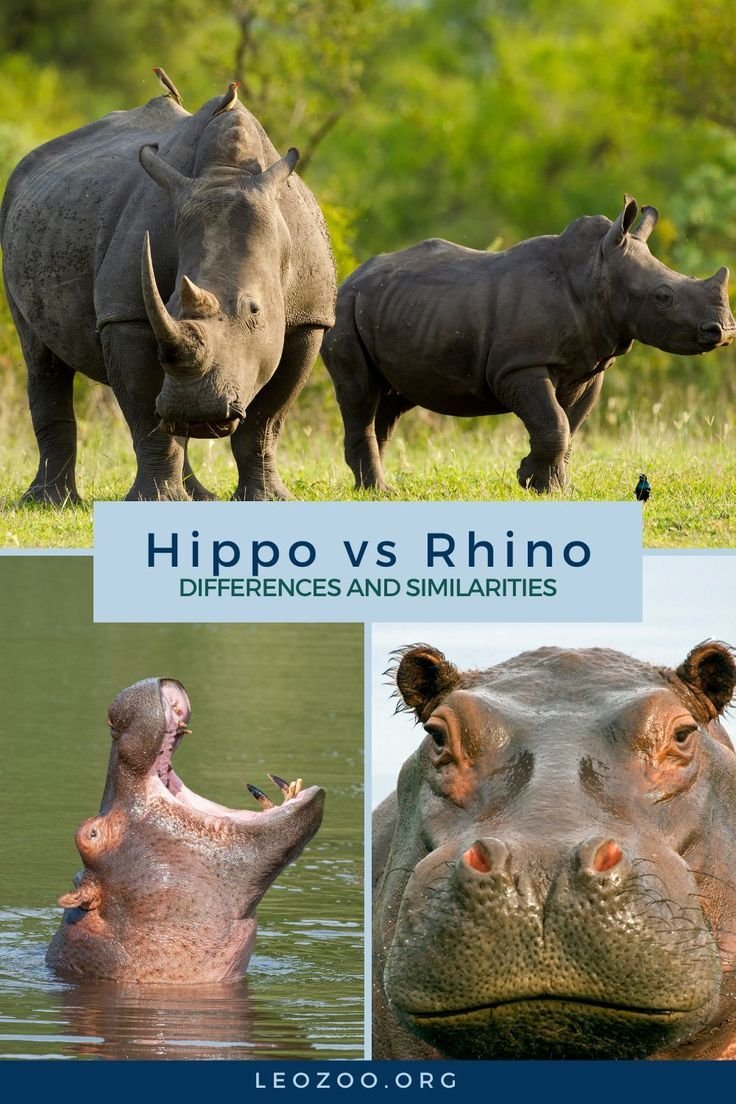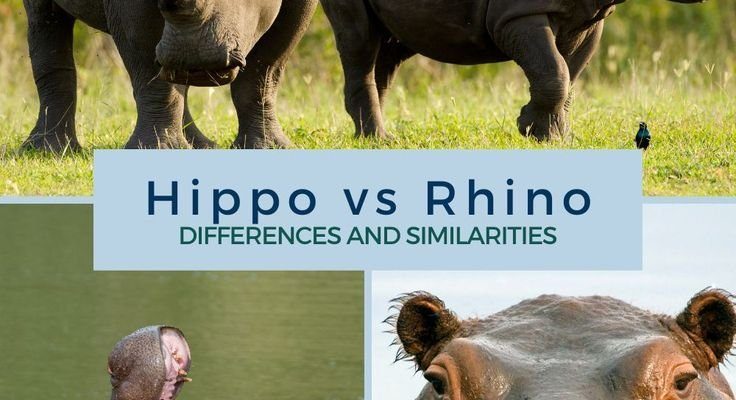
Now, you might be wondering, “What other animals are similar to rhinos?” Well, let’s take a leisurely stroll through the animal kingdom and discover ten animals that have a thing or two in common with our armored friend. We’ll look at how they compare, what sets them apart, and maybe even uncover some little-known facts along the way.
1. Hippos
Hippos are often considered rhinos’ closest relatives. They share a hefty build and herbivorous diets, but that’s where the similarities start to diverge. While rhinos have tough, thick skin and are mostly solitary, hippos prefer to wallow in groups. You can spot a hippo lounging in a river, often with just their eyes and nostrils peeking above the water.
One of the most striking differences is their body shape. Hippos have a more barrel-like shape and shorter legs compared to rhinos. Additionally, hippos possess large, powerful jaws filled with sharp teeth, whereas rhinos have a more straightforward grazing mouth structure. Despite their docile daytime behavior, hippos can be surprisingly aggressive, especially when defending their territory.
2. Tapirs
If you’ve never seen a tapir, you might think of a rhino in miniature. These animals have a similar body shape but are much smaller and come with a unique, elongated snout that resembles a short trunk. Tapirs are generally found in forested regions and are tropical dwellers, which sets them apart from most rhino species that thrive in savannas or grasslands.
While both animals are herbivores, tapirs enjoy a diverse diet that includes fruits, leaves, and aquatic plants. They have a shy demeanor and are more adept at hiding from predators than a rhino, which stands its ground. It’s interesting to note that their skin is also sensitive, although not as tough as a rhino’s.
3. Warthogs
Warthogs might look a bit scruffy compared to our polished rhino buddies, but they share some interesting traits. Both are part of the ungulate family, meaning they have hooves and are plant-eaters. Warthogs are much smaller, but their stocky build and tough demeanor resonate with the ‘big animal’ vibe you get from rhinos.
The key differentiator is the warthog’s facial structure. They’ve got distinct tusks that flare out, and their skin is much more exposed, making them look a bit rugged. You might find them foraging in savannas, looking for roots and tubers, while rhinos munch on grass or browse leaves high up in trees.
4. Elephants
Elephants are another prominent figure in the wildlife kingdom, and they have a lot in common with rhinos. They share a similar size and habitat, often roaming the same regions in Africa and parts of Asia. Both animals are herbivorous, relying on vast amounts of vegetation to sustain their massive bodies.
However, the differences are quite pronounced. Elephants have long trunks and larger ears for temperature regulation, whereas rhinos are more compact and lack these features. Elephants have social structures, forming tight family groups, unlike the more solitary nature of most rhinos. Their communication is also fascinating, using a range of vocalizations, from trumpets to low rumbles that can travel miles.
5. Giraffes
At first glance, giraffes and rhinos might seem worlds apart. However, both share a herbivorous lifestyle in the African savanna. Rhinos tend to graze or browse for food, while giraffes reach for leaves high up in trees with their long necks.
The major distinction lies in their body adaptations. Giraffes are built for height and agility, using their long legs and necks to their advantage. On the other hand, rhinos are robust and built for strength, with thick skin providing protection from predators. While they might coexist in the same habitats, their feeding strategies highlight the diversity of adaptation within these gentle giants.
6. Buffalo
The African buffalo, known for its formidable horns and stocky build, shares habitat similarities with rhinos. Both are large herbivores that roam the savanna, often found in herds. Buffaloes often graze alongside rhinos, creating a picturesque scene of massive animals dotting the landscape.
Yet, when it comes to their social behaviors, buffalo tend to have a close-knit group dynamic, providing strength in numbers against predators. In contrast, rhinos are generally more solitary creatures, especially the black rhino species. The buffalo’s thick, curved horns are distinctive and can be quite menacing, whereas rhinos lack notable facial adornments.
7. Bison
Bison, particularly the American bison, are often confused with rhinos due to their large size and shaggy appearance. Both animals have a robust build and graze on grasslands, making them formidable in the wild.
However, bison have a more rounded body shape with prominent humps on their backs. Their fur is thick and woolly, providing insulation in colder climates, unlike the rhino’s smooth skin. While rhinos are typically solitary or have small family units, bison are highly social and can form massive herds. Their social structure revolves around communal living, providing safety in numbers.
8. Camels
Surprisingly, camels might not be the first animal that comes to mind when thinking of rhinos. However, both animals are incredibly adaptable and thrive in harsh environments—rhinos in the savanna and camels in arid deserts. While they differ in appearance, both are herbivores that can go extended periods without water.
One major difference is the camel’s unique hump, used for fat storage. This adaptation allows them to survive in extreme heat, while rhinos rely on their thick skin for protection against the sun and predators. Interestingly, both animals exhibit strong maternal instincts, caring deeply for their young.
9. Mooses
Moose are the largest members of the deer family and can be somewhat rhino-like in size. Both are herbivores, grazing on vegetation, although moose add a flair by foraging for aquatic plants. Their distinct antlers, which can grow quite large, set them apart from rhinos, whose heads are mostly horn-topped.
While they share a similar herbivorous routine, moose are typically found in colder climates like northern forests. Their long legs and adaptations for cold weather are a stark contrast to the warm savanna dwellers like rhinos. Moose tend to be pretty solitary, similar to black rhinos, but they can also form small groups during breeding season.
10. Saiga Antelope
The saiga antelope is a lesser-known but fascinating creature that shares some traits with rhinos. These antelopes are unique, with their large, bulbous noses that help filter dust from the dry grasslands they inhabit. Their size is much smaller than a rhino, but both are part of the herbivore family.
Saigas and rhinos face similar threats from habitat loss and poaching. While rhinos are more robust and are known for their incredible bulk, saigas are known for their agility and smaller frame. Their distinctive physical traits make them recognizable, but both animals showcase how diverse adaptations can evolve in herbivores.
In conclusion, exploring these animals similar to the rhinoceros not only broadens our appreciation for these magnificent creatures but also highlights the incredible diversity within nature. Each of these animals adapts beautifully to their environments, showcasing the variety of life on our planet. So, next time you spot a rhino or one of these similar species, take a moment to appreciate the unique traits that make each one special in its own right.

